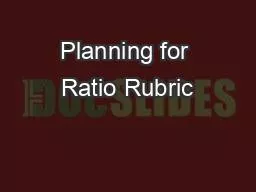

CUThe purpose of this rubric is to help leaders and teachers evaluate and understandwhat it looks like to plan and execute lessons that use ratio techniques to put the heavy lifting on studentsUse the ID: 896278
Download Pdf The PPT/PDF document "Planning for Ratio Rubric" is the property of its rightful owner. Permission is granted to download and print the materials on this web site for personal, non-commercial use only, and to display it on your personal computer provided you do not modify the materials and that you retain all copyright notices contained in the materials. By downloading content from our website, you accept the terms of this agreement.
1 CU Planning for Ratio Rubric . The pu
CU Planning for Ratio Rubric . The purpose of this rubric is to help leaders and teachers evaluate and understand what it looks like to plan and execute lessons that use ratio techniques to put the heavy lifting on s tudents. Use the resource during classroom observations or when re viewing a video of instruction. 4 - Exemplary 3 - Proficient 2 - Emerging 1 – Needs Improvement Logical Sequence of Information The sequence of information the teacher asks students to investigate is logical, draws on prior knowledge, and consistently asks students to make high level connections. The sequence of information the teacher asks students to investigate is logical, dr aws on prior knowledge, and asks students to make high level connections most of the time. The sequence of information the teacher asks students to investigate may contain some gaps, does not access prior knowledge, or does not ask students to make high l evel connections. The sequence of information the teacher asks students to investigate contains gaps, does not access prior knowledge, and does not ask students to make high level connections. Problem Context The opening question focuses on gauging s tudents’ understanding of the problem’s context. All other questions and answers are couched in the context of the problem. The opening question focuses on gauging students’ understanding of the problem’s context. Most of the other questions and answers are couched in the context of the problem. The opening question does not focus on gauging students’ understanding of the problem’s context , or other questions and answers are not couched in the context of the problem. The opening question does not focus on gauging students’ understanding of the problem’s context , and other questions and answers are not couched in the context of the problem. Ratio Techniques Each question in the lesson is scripted with a n appropriate ratio technique , and all techniques are labeled. Each question in the lesson is scripted with a ratio technique , most techniques are appropriate , and some techniques are labeled. Most questions in the lesson are scripted with a ratio technique , some techniques are appropriate , and some techniques are labeled. Some questions in the lesson are scripted using ratio techniques , but techniques are not labeled. Ratio ( In Classroom Instruction) The students are doing more than 75% of the thinking, speaking, and writing. The explicit and implicit ratio techniques from the lesson plan are visible. The teacher and student s embrace the productive struggle. The students are doing more than 50% of the thinking, speaking, and writing. The explicit and implicit ratio techniques fro m the lesson plan are visible. The teacher and student s embrace the productive struggle. The students are doing 30 – 50% of the thinking, speaking, and writing. Some of the explicit and implicit ratio techniques from the lesson plan are visible. The teache r and student s sometimes embrace the productive struggle. The students are doing less than 30% of the thinking, speaking, and writing. Few of the explicit and implicit ratio techniques from the lesson plan are visible. The teacher and student s do not embrace the productive struggle.